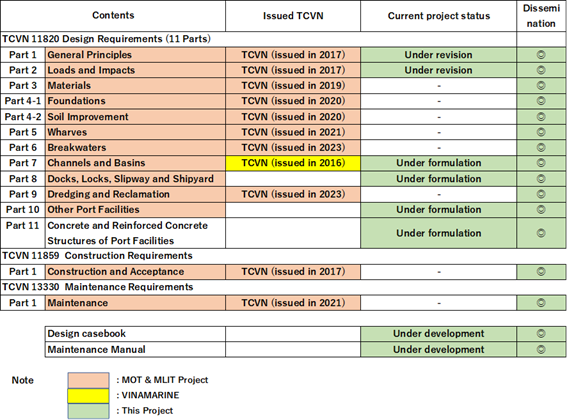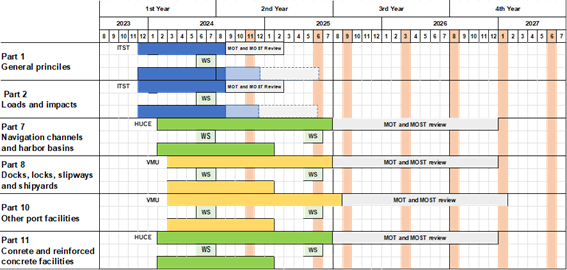Project on the development and dissemination of National Technical Standards in Viet Nam
1. Outline of the Project
VINAMARINE is currently implementing a project to formulate and disseminate national technical standards (TCVN) for seaport facilities in cooperation with a JICA survey team (OCDI) based on the memorandum of understanding (RD) agreed upon between the Ministry of Transport (MOT) of Vietnam and the Japan International Cooperation Agency (JICA) of Japan.
This project is a continuation of the project that MOT began with the Japanese Ministry of Land, Infrastructure, Transport and Tourism (MLIT) in 2014 based on a Memorandum of Understanding for developing port technical standards. Under this joint Vietnam-Japan framework, Vietnamese technical standards for design, construction and maintenance management of seaports were created based on based on Japan’s Technical Standards for Port and Harbour Facilities. Between 2014 and 2023, 10 TCVNs were formulated and promulgated. These included TCVN 11820 (design requirements) which were composed of 8 TCVNs, TCVN 11859 (construction and acceptances) and TCVN 13330 (maintenance) which are highlighted in brown in Table-1.
In the current project, we are creating new 4 TCVNs and revising 2 TCVNs that have already been developed and promulgated (indicated in green in Table-1 below). This project is scheduled to be carried out over a four-year period from August 2023 to July 2027.
Table-1: Scope of work and task allocation

The following Technical Standards (TCVN11820) are to be “revised and developed” in this project:
Part 1 General Principle (revision of TCVN issued in 2017)
Part 2 Loads and Impacts (revision of TCVN issued in 2017)
Part 7 Navigation channels and harbor basins (newly developed)
Part 8 Docks, Locks, Slipways and Shipyards (newly developed)
Part 10 Other Port Facilities (newly developed)
Part 11 Concrete and Reinforced Concrete Structures (newly developed)
Note: The facilities covered by Part 10 “The other port facilities” are single-mooring buoys, cruise terminals and marinas.
In the second half of the project, we will conduct dissemination activities for the revised and newly formulated TCVNs as well as for all of the TCVNs developed by MOT and MLIT.
In addition, since many have commented that it is difficult to actually design port facilities simply by reading technical standards, a design casebook with eight design case studies will be prepared. Furthermore, in order to properly maintain and manage the increasing number of port facilities, we are also preparing a maintenance manual that introduces more specific maintenance methods.
The above-mentioned port technical standards (TCVNs), Design casebook, and Maintenance Manual will be prepared in English and Vietnamese versions.
2. Revision and new development works for TCVN11820
The two revision works and four new development works for TCVN11820 are to be carried out according to the schedule in Figure-1.
Figure 1: Schedule of works for revision and new development of TCVN11820

For Parts 1 and 2, a workshop (WS) was held in July 2024 to obtain comments from stakeholders on the drafts developed by the working group (WG), and based on those comments, the necessary revisions were made and a final draft was prepared at the end of August. VINAMARINE submitted it to MOT in mid-December. After review by MOT, the draft will be submitted to the Ministry of Science and Technology (MOST), which will review it and promulgate it as the TCVN.
For the four new TCVNs to be developed, each working group held a workshop in July 2024 to obtain comments and discuss the draft table of contents and development policy of the TCVNs prepared by each working group. Each working group is currently developing a draft based on those comments.
By the end of April 2025, drafts of the TCVNs will be developed and comments on them will be solicited from a wide range of stakeholders. Workshops on the TCVNs will be held at the end of May or beginning of June to discuss these comments. The WGs will then make the necessary revisions and prepare final drafts of the TCVNs, which VINAMARINE will then submit to MOT. These final drafts will be reviewed by MOT and MOST before being promulgated as new TCVNs.
3. Design casebook and Maintenance manual
In order to help designers understand how to use the criteria specified in the TCVN for seaport facilities in their actual designs, a design casebook will be developed. It will include the following eight design cases.
(1) Mooring facilities 1) Gravity-type Quaywall (Caisson-type)
2) Sheet-pile type Quaywall
3) Open-type wharf
(2) Breakwaters 1) Gravity-type breakwater (Caisson-type)
2) Sloping breakwater
(3) Soil improvement methods
1) Deep mixing methods
2) Sand compaction pile methods
(4) Other facilities 1) Dolphin
In addition, TCVN on maintenance has been promulgated as TCVN13330, but it does not describe in detail the specific maintenance work methods or how to implement them. Therefore, a maintenance manual that specifically describes these methods will also be prepared and published.
The design casebook and maintenance manual will be prepared according to the following schedule. Both will be periodically updated based on comments received.

Figure-2: Schedule for developing design casebook and maintenance manual
4. Measures to disseminate national technical standards
To disseminate TCVNs for Seaport facilities, the following measures are being or will be implemented.
(1) A technical standards section has been established on VINAMARINE’s website.
This section will provide a wide range of information on the following:
- Status of revised and newly developed TCVNs for seaport facilities
- Introduction of the draft TCVN that is being developed
In addition, an inquiry section for technical standards will be prepared. (Questions can be submitted by e-mail)
(2) Workshops will be held during the development of the TCVNs to provide an opportunity to obtain comments from many stakeholders. The next workshops are scheduled to be held around June 2025.
(3) Seminars are scheduled to be held after the new TCVNs are promulgated so that many people can become familiar with their contents.
The seminars are scheduled to be held three times. The first will be held in Hanoi and Ho Chi Minh City in June 2025. Subsequent seminars are tentatively being planned in Central Vietnam in addition to the two aforementioned cities.
(4) TCVNs have been separated into various parts, but it is important to understand that all parts are relevant to one another. Accordingly, all TCVNs may be put on a single USB memory stick and distributed to seminar participants.
(5)Training for engineers actually engaged in design is also planned to be provided in order to have them master design practices.


